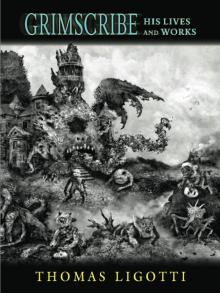Read Grimscribe: His Lives and Works Storyline:
Grimscribe: His Lives and Works is the second volume in a series of revised, definitive editions of the horror story collections of Thomas Ligotti. First published in 1991 by Carroll & Graf in the United States and Robinson Publishing in England, Grimscribe garnered significantly more recognition than Ligotti’s first collection, Songs of a Dead Dreamer, which was issued two years earlier by the same publishers.In the view of many commentators, it was with Grimscribe that Ligotti consolidated his reputation as a horror writer of high stature. As Steven J. Mariconda remarked in a 1992 essay surveying the stories in Songs of a Dead Dreamer and Grimscribe: “Of the two collections, Grimscribe achieves near-classic status and is recommended to all.” Included in this volume is “The Last Feast of Harlequin,” a novella that, in the observation of H. P. Lovecraft scholar and biographer S. T. Joshi, “may perhaps be the very best homage to Lovecraft ever written.”Like the stories in Songs of a Dead Dreamer, the first title of Ligotti’s to be published in a revised, definitive edition by Subterranean Press, those presented here in Grimscribe: His Lives and Works have been amended to realize the full artistic aims of the originals rather than to compose new versions of these works. This volume may thus be considered, in the manner of its predecessor in this series, as both as a reissue and the culminating specimen of its master effort of twenty years ago.From Publishers WeeklyThe eponymous first-person narrator of this chilling collection assumes many different guises in spinning his eerie tales, but the voice in each of the 12 stories remains the same, a voice "always speaking of terrible secrets." Witness, participant, victim, Grimscribe is, above all, our guide through a landscape at once relentlessly dark and luminously revealing, where a "brood of dark forms" push "through the fog" and "dark bricks that bulge like tumors" appear "on the facades of houses." Prisoners of this bleak but fascinating world include a mild-mannered village schoolteacher sent in "Flowers of the Abyss" to discover the awful truth behind a house in which an entire family perished horribly; in "The Cocoons" we encounter a man trapped in a unique doctor/patient relationship who finds the treatment infinitely more agonizing than the disease; instead of the three Rs, the young boy in "Miss Plarr" receives from his tutor a few lessons in "the sound of something that stings the air." Stylishly wrought in the best tradition of the American gothic and wonderfully reminiscent of Poe and Hawthorne, these scary stories transcend their genre. and command respect. Ligotti wrote Songs of a Dead Dreamer. Copyright 1991 Reed Business Information, Inc. From Kirkus ReviewsHigh-style horror stories in a classic literary mode, in expressiveness not far from the American masters, Poe and H.P. Lovecraft. Ligotti (Songs of a Dead Dreamer, 1990) writes out of what seems an all-embracing depression, making him willing to go into wipeout areas time and again and ask a lot both of himself and his readers. His narrators seldom effect any change; they simply observe a superbly described inner state, then leave, hungover. In "The Last Feast of Harlequin," a professor obsessed with clowns locates a clown festival in the midwestern town of Mirocaw. He goes to observe and join the townsfolk in their festival, perhaps wearing his clown suit. But the festival is not meant for him. In fact, it is two festivals, one within the other, the inner one being a cruel festival of freaks who are detested and beaten by members of the larger clown festival. He joins the freaks and follows them out of town and down a hole in the earth wherein they have borne their frigid Winter Queen. In a cavernous earthen hall, the freaks begin turning into huge worms, and he flees up the black wormhole by which he entered. In "The Glamour," the narrator enters a weird boarded-up movie house to find himself in a sparse audience surrounded by purple lights and seated amid hairy threads that bind all to their seats as they watch a cobweb screen on which is shown grisly purple organs being operated on. He leaves before he can be imprisoned by the floating and crawling hairs. In "The Night School," he enters a dark, weird schoolground where strange figures stand around misshapen metal drums in firelight; then he goes into the hideously rotting school for a bizarre class inmeasurement of cloacal forces. Time as a flow of sewage. The excrement of space, scatology of creation...'' He leaves, finding the moon "coated with a luminous mold, floating...in the great sewers of the night.'' Thirteen tales out of a maggoty delirium. -- Copyright ©1991, Kirkus Associates, LP. All rights reserved.Pages of Grimscribe: His Lives and Works :
